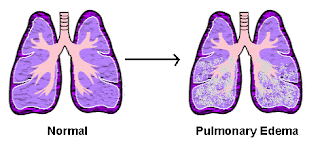Pulmonary edema is a condition caused by excess fluid in the lungs. This fluid collects in the numerous air sacs in the lungs, making it difficult to breathe.
In most cases, heart problems cause pulmonary edema. But fluid can accumulate for other reasons, including pneumonia, exposure to certain toxins and medications, trauma to the chest wall, and exercising or living at high elevations.
 Pulmonary edema that develops suddenly (acute pulmonary edema) is a medical emergency requiring immediate care. Although pulmonary edema can sometimes prove fatal, the outlook improves when you receive prompt treatment for pulmonary edema along with treatment for the underlying problem. Treatment for pulmonary edema varies depending on the cause but generally includes supplemental oxygen and medications.
Pulmonary edema that develops suddenly (acute pulmonary edema) is a medical emergency requiring immediate care. Although pulmonary edema can sometimes prove fatal, the outlook improves when you receive prompt treatment for pulmonary edema along with treatment for the underlying problem. Treatment for pulmonary edema varies depending on the cause but generally includes supplemental oxygen and medications.
Causes
Pulmonary edema is often caused by congestive heart failure. When the heart is not able to pump efficiently, blood can back up into the veins that take blood through the lungs.
As the pressure in these blood vessels increases, fluid is pushed into the air spaces (alveoli) in the lungs. This fluid reduces normal oxygen movement through the lungs. These two factors combine to cause shortness of breath.
Congestive heart failure that leads to pulmonary edema may be caused by:
- Heart attack, or any disease of the heart that weakens or stiffens the heart muscle (cardiomyopathy)
- Leaking or narrowed heart valves (mitral or aortic valves)
- Sudden, severe high blood pressure (hypertension)
Pulmonary edema may also be caused by:
- Certain medicines
- High altitude exposure
- Kidney failure
- Narrowed arteries that bring blood to the kidneys
- Lung damage caused by poisonous gas or severe infection
- Major injury
Symptoms
Symptoms of pulmonary edema may include:
- Coughing up blood or bloody froth
- Difficulty breathing when lying down (orthopnea)
- Feeling of "air hunger" or "drowning" (This feeling is called "paroxysmal nocturnal dyspnea" if it causes you to wake up and try to catch your breath.)
- Grunting, gurgling, or wheezing sounds with breathing
- Problems speaking in full sentences because of shortness of breath
Other symptoms may include:
- Anxiety or restlessness
- Decrease in level of alertness (consciousness)
- Leg or abdominal swelling
- Pale skin
- Sweating (excessive)
Exams and Tests
The health care provider will listen lungs and heart with a stethoscope to check for:
- Abnormal heart sounds
- Crackles in your lungs, called rales
- Increased heart rate (tachycardia)
- Rapid breathing (tachypnea)
Other things that may be seen during the exam include:
- Leg or abdominal swelling
- Abnormalities of your neck veins (which can show that there is too much fluid in your body)
- Pale or blue skin color (pallor or cyanosis)
Possible tests include:
- Blood chemistries
- Blood oxygen levels
- Chest x-ray
- Complete blood count (CBC)
- Echocardiogram (ultrasound of the heart) to see if there are problems with the heart muscle
- Electrocardiogram (ECG) to look for signs of a heart attack or problems with the heart rhythm
Treatment
Pulmonary edema is almost always treated in the emergency room or hospital. You may need to be in an intensive care unit (ICU).
- Oxygen is given through a face mask or tiny plastic tubes are placed in the nose.
- A breathing tube may be placed into the windpipe (trachea) so you can be connected to a breathing machine (ventilator) if you cannot breathe well on your own.
The cause of edema should be identified and treated quickly. For example, if a heart attack has caused the condition, it must be treated right away.
Medicines that may be used include:
- Diuretics that remove excess fluid from the body
- Medicines that strengthen the heart muscle, control the heartbeat, or relieve pressure on the heart
Prognosis
The outlook depends on the cause. The condition may get better quickly or slowly. Some people may need to use a breathing machine for a long time. If not treated, this condition can be life-threatening.

Post a Comment
If you have any doubts, please let me know